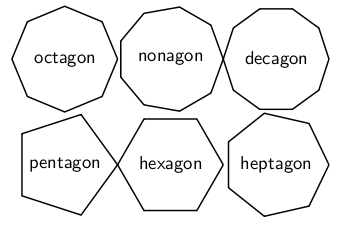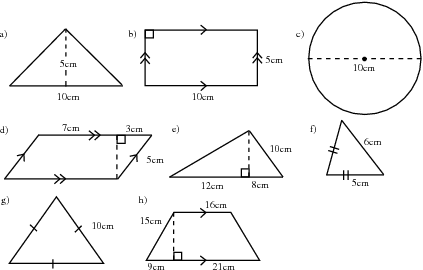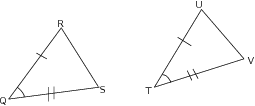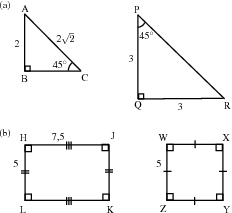Other polygons
There are many other polygons, some of which are given in the table below.
| Sides |
Name |
| 5 |
pentagon |
| 6 |
hexagon |
| 7 |
heptagon |
| 8 |
octagon |
| 10 |
decagon |
| 15 |
pentadecagon |
Table of some polygons and their number of sides.
 Examples of other polygons.
Examples of other polygons.
Angles of regular polygons
You can calculate the size of the interior angle of a regular polygon by using:
where
is the number of sides and
is any angle.
Areas of polygons
- Area of triangle:
base
perpendicular height

- Area of trapezium:
(sum of
(parallel) sides)
perpendicular height

- Area of parallelogram and rhombus: base
perpendicular height

- Area of rectangle: length
breadth

- Area of square: length of side
length of side

- Area of circle:
x radius

Khan academy video on area and perimeter
Khan academy video on area of a circle
Polygons
- For each case below, say whether the statement is true or false. For false statements, give a counter-example to prove it:
- All squares are rectangles
- All rectangles are squares
- All pentagons are similar
- All equilateral triangles are similar
- All pentagons are congruent
- All equilateral triangles are congruent
- Find the areas of each of the given figures - remember area is measured in square units (cm
, m
, mm
).

Summary
- Make sure you know what: quadrilaterals, vertices, sides, angles, parallel lines, perpendicular lines,diagonals, bisectors and transversals mean.
- Similarities and differences between quadrilaterals
- Properties of triangles and quadrilaterals
- Congruency of triangles
- Classification of angles into acute, right, obtuse, straight, reflex or revolution
- Theorem of Pythagoras which is used to calculate the lengths of sides of a right-angled triangle
- Angles:
- Acute angle: An angle 0 and 90
- Right angle: An angle measuring 90
- Obtuse angle: An angle 90 and 180
- Straight angle: An angle measuring 180◦
- Reflex angle: An angle 180 and 360
- Revolution: An angle measuring 360
- Angle properties and names
- Equilateral, isoceles, right-angled, scalene triangles
- Triangles angles = 180
- Congruent and similar triangles
- Pythagoras
- Trapezium, parm, rectangle, square, rhombus, kite and properties
- Areas of particular figures
Exercises
- Find all the pairs of parallel lines in the following figures, giving reasons in each case.
-

-

-

- Find angles
,
,
and
in each case, giving reasons.
-

-

-

- Which of the following claims are true? Give a counter-example for those that are incorrect.
- All equilateral triangles are similar.
- All regular quadrilaterals are similar.
- In any
with
we have
.
- All right-angled isosceles triangles with perimeter 10 cm are congruent.
- All rectangles with the same area are similar.
- Say which of the following pairs of triangles are congruent with reasons.
-

-

-

-

- For each pair of figures state whether they are similar or not. Give reasons.

Challenge problem
- Using the figure below, show that the sum of the three angles in a triangle is 180
. Line
is parallel to
.





















